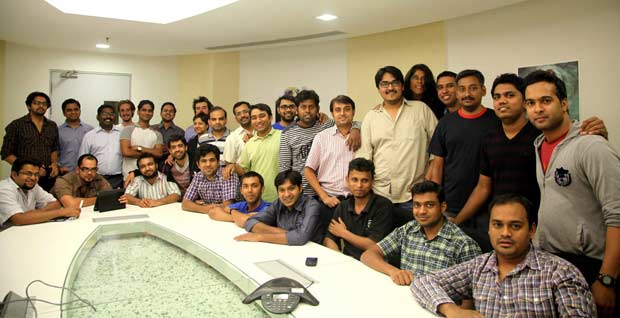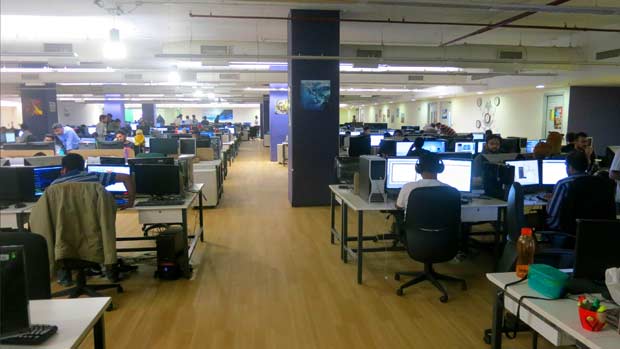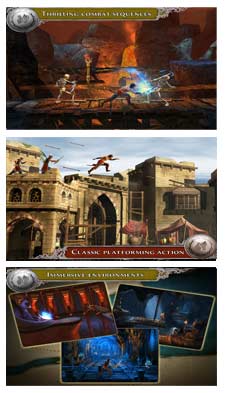
 Animationxpress.com’s Zeenia Boatwala recently caught up with Sashi Menon- Producer at Ubisoft Pune to know more the detailed making of their latest game ‘Prince of Persia the Shadow and the Flame’.
Animationxpress.com’s Zeenia Boatwala recently caught up with Sashi Menon- Producer at Ubisoft Pune to know more the detailed making of their latest game ‘Prince of Persia the Shadow and the Flame’.
Here are the Excerpts…
Has Ubisoft Pune solely developed this game?
Yes, the entire creation and development was handled in-house. This includes design, art, audio and programming. We also worked closely with Ubisoft’s mobile division at HO regarding specific design details, applicable 3rd party tools.
Please share the game play with us, what are the main game play elements involved in the game?
Prince of Persia the Shadow and the Flame is a continuation to the Classic version wherein the Prince needs to once again defeat his arch nemesis Jaffar who is back from the dead. The storyline takes you through 4 varied environments spread across 14 levels. Throughout the Prince’s journey he is faced with various traps and puzzles that test his speed and agility on top of the challenges that different enemy archetypes throw during the combat mode.
When did the game release and how has the response been?
The game was released on Jul 25th ’13 on iTunes, Google Play and Amazon store simultaneously. The response has been very good in general. We were featured on all the 3 platforms and also had some great reviews from some gaming sites. In fact, we scored a 5/5 on SlidetoPlay!!
Who is the targeted audience for this game?
We always knew that our core audience would be fans of the IP and especially those who had played the original version. But we also took into consideration the casual audience who form a bulk of the touch screen devices and catered to their needs as well during development.
What kind of approaches and visions have gone into the making of this game?
We knew based on the results from the Classic version (that was developed in-house at Pune as well) that retro’s still had a special place with a lot of gamers. At the same time we also realized from the game reviews that a lot more could be done to further adapt and redefine the game according to today’s standards and expectations. We were now looking at a different set of audience which consisted of a majority of casual players. The touchscreen interface itself required us to adapt the controls and camera to suit the platform better which in turn resulted in modifying the original level design as well.
Talking about the major priority factors, what were the ones while building this game?
The first thing we did was to heavily prototype on the controls which resulted in the gesture based system that is ideally suited for a touchscreen device on top of polishing the standard joystick controls. Apart from that we also modified certain sections of the level design, traps, puzzles to make it less of trial and error while at the same time keeping it challenging at all points. The combat system was also reworked by introducing elements of strategy and tactics via the stealth kill combos and multiple enemy fights.
How was the planning for this game like, mostly the story lines, characters, you yourself must be imagining you in their places and designing the game?
We had a constraint right from the start: The game needed to be appreciated by the retro fans that had played the original version as well. However, we did modify many aspects like the level design, enemy’s behavior, props, environment visuals etc. in order to have a stronger bond between the story and the player experience.
What are the emotions that you would like to bring into the players as they worked through your game?
We worked a lot on the gameplay immersion for the player. The level design, props, enemy staging etc. have been designed specifically to showcase the Prince’s journey during his moments of deceit, despair, hope and triumph ultimately. From a player’s point of view revenge was one big factor aside from being an explorer in a deadly environment while being sneaky/clever when approaching enemies for stealth kill.
Could you put light on the pre-production, concept, story line finalization stages, how much reworking was done on the concept and stories?
We stuck to the original storyline as far as possible. However, we adapted it to make it sound as the Prince’ first hand narration rather than a generic storybook kind of effect. Additionally, we also introduced switching between past memory v/s present kind of a storytelling effect that engrossed the player further. Further, we introduced certain traps, elements into the gameplay that fit better with the specific environments and the story as well.
So how much time did the overall game creation take?
The entire creation took about 8-9 months in total with a team of about 25 during peak production.
Can we have a credit run down for this game?
Prince of Persia the Shadow and the Flame was made by a team of about 25 people at Ubisoft Pune, India. The best part about the team was the diversity in terms of experience coming from various platforms as our studio has been involved with projects on Xbox, PS3, Nintendo DS, FB and Mobile. On iOS and Android platforms specifically, we had previously worked on Prince of Persia Classic, Assassins Creed Rearmed, Big Bond Theory among some other games.

Would you like to share the research, influences taken into consideration for building the game?
We already had a base reference to count on in the form of Prince of Persia Classic that was developed by us as well. A lot of study was done based on the player reviews and the tracking information that we had on our hands. That apart, we also did comparative studies on the positive and negative points for our closest competitor games. All this in general helped us make decisive design guidelines for the team to follow.
How did you test the game?
We have an internal QC team in our studio; part of who are dedicated at expertising on the touchscreen devices. The entire testing was done internally along with dedicated dev-testers who were seated right next to the developers. Testing was not only limited to pointing out bugs but also to help improve the quality of the game by providing suggestions to improve the game’s quality overall.
How did you set the difficulty?
Setting the difficulty was a continuous process that lasted until the finishing stages. We had a lot of iterations on the placement of traps, gameplay ingredients, combat progression etc. In order to achieve a balanced setting various playtest were conducted inside our studio as well as dedicated playtest labs on players who were either fans of the brand or those who were accustomed to touchscreen devices in general.
Please elaborate more on the design/ look and feel of the game like and the factors that led you to choose this design?
We knew from the start that the game could not be introduced as it was to the current audience. Today’s audience on the touchscreen are more of casual players which in turn made us focus more on improving the accessibility, visuals and the gameplay itself to make it simple but challenging at the same time! This in-turn led to intuitive gesture controls both for the plat forming and the combat scenarios. Also, we realized that certain players wanted to complete the game faster without having to explore every nook and corner of the levels; for them we introduced the in-app purchases. We thus tried to create a game system that appeased both the traditional explorers as well as the modern day casual gamers.
What kind of animation has gone into creating this game, why did you settle with this animation medium?
The base animation style for the Prince was already defined by the various games in the series. We were basically looking to project the prince as an agile and aggressive protagonist. Further, in order to provide the players with additional comfort we ensured that most of the key animations were interruptible at any point of time. This is turn gave complete control to the player on the prince’s plat forming ability.
Could you give an in-depth insight about the making and how much time did you put in for production and post production?
The idea to work on this game came about after the success on Prince of Persia Classic. In fact we received several comments from the fans asking for this sequel. Initially we started out as a small team but realized very soon that the expectation and the benchmark we had set for ourselves required far more involvement. We prototyped a lot initially which in turn helped us create a solid base architecture that could handle further improvements during the production process relatively easily without having to modify a lot. Overall, we spent about 4 months on production and about 2-3 months on the post-production.

What was the toughest part of development?
Prince of Persia brand in it is huge and there is always pressure while creating a game of its stature. We had to be on par at least if not better compared to the best games on the platform today. There is also the fans sentiment that needs to be considered. That is quite a big challenge!
As with any game development there were of course many difficulties that we faced during its creation. One of our primary concerns was to limit the game within 50 MB while at the same time ensuring high quality in terms of visuals. Hence, a lot of assets had to be re-used throughout the game but it is not visible to a normal player because of some excellent work on lighting that created the desired variations within the levels. Another big challenge for us was to simultaneously release the game on iTunes, Google Play and the Amazon store. We went about this by creating a common architecture right from the start and having periodic checks across all the platforms at regular intervals on top of testing continuously on the master device.
What are the elements that you would like to tweak and make a newer version of this game?
If provided with an option that does not constraint game development with time/budget limits we could easily spend another 6 months at least on improving the game. Maybe, we could have worked further on some points like increasing the depth during combat or the Cinematics presentation etc. But given the constraints we are quite happy with the overall product and for sure are proud about it.
 What sort of technology has gone into developing the game?
What sort of technology has gone into developing the game?
ShiVa 3d was the engine used to create the game. We knew from the start that there would be a lot oftechnical challenges considering the target we had set for ourselves. Thanks to the close collaboration between our technical experts and the engine provider we were able to pull it off without too many issues.
Is the game free or paid?
The game is paid and is available for 2.99$ on the iTunes/Google Play/Amazon store.
Please put light on the forthcoming releases that Ubisoft Pune is gearing up for?
We are working on various projects in the studio including some AAA’s. Some of them are being developed in-house while the others are in collaboration with other studios. Ubisoft is perhaps one of the few organizations where several projects are collectively developed across various studios worldwide which in turn are a fun and learning process for all.

